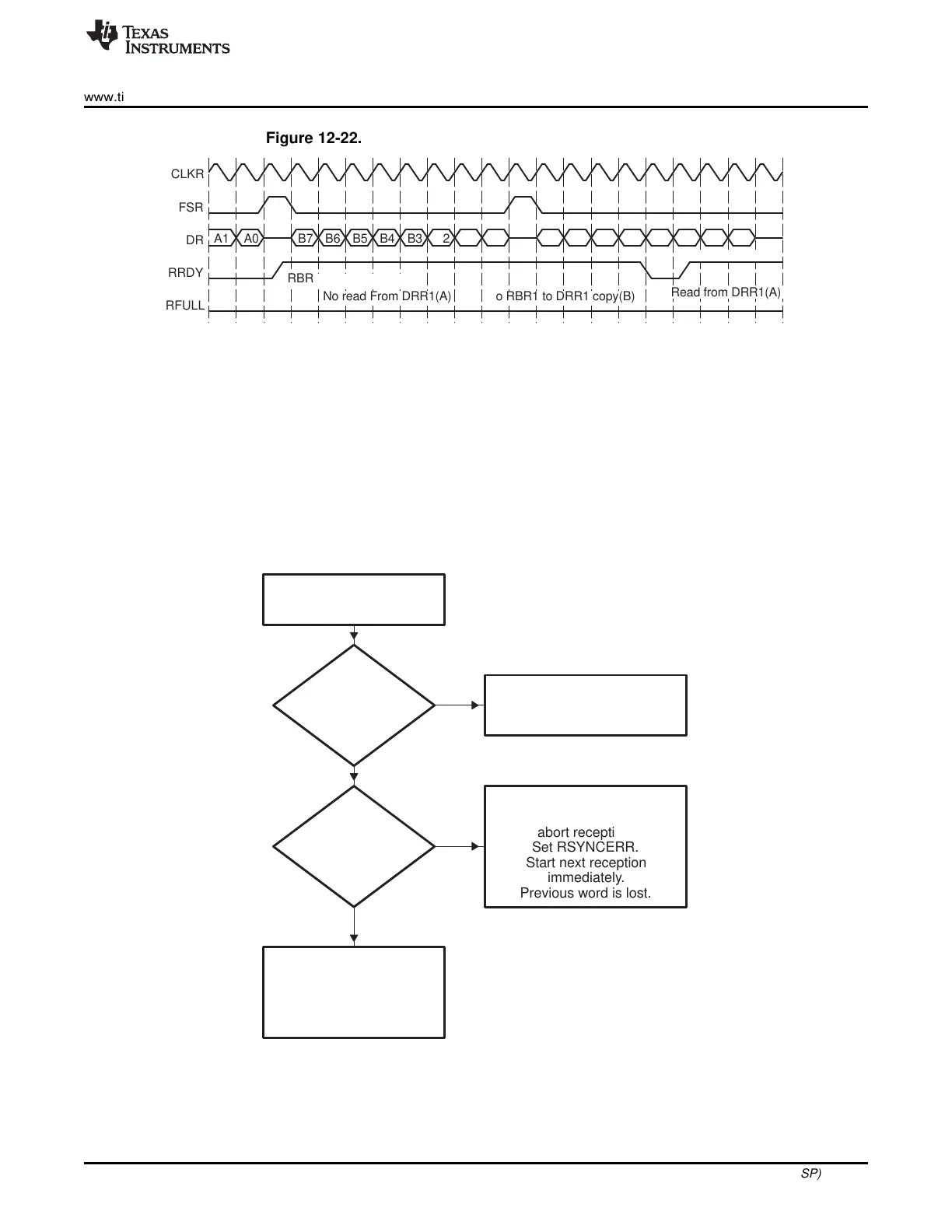Yes
No
Yes
No
running.
Receiver continues
ignore frame pulse.
With frame ignore,
Case 1:
ÁÁÁÁÁÁÁÁÁÁ
ÁÁÁÁÁÁÁÁÁÁ
ÁÁÁÁÁÁÁÁÁÁ
ÁÁÁÁÁÁÁÁÁÁ
ÁÁÁÁÁÁÁÁÁÁ
ÁÁÁÁÁÁÁÁÁÁ
ÁÁÁÁÁÁÁÁÁÁ
ÁÁÁÁÁÁÁÁÁÁ
Previous word is lost.
immediately.
Start next reception
Set RSYNCERR.
abort reception.
Without frame ignore,
Case 3:
Start receiving data.
Normal reception.
Case 2:
ÁÁÁÁÁÁÁÁÁ
ÁÁÁÁÁÁÁÁÁ
ÁÁÁÁÁÁÁÁÁ
ÁÁÁÁÁÁÁÁÁ
ÁÁÁÁÁÁÁÁÁ
pulse occurs.
Receive frame-sync
?
RFIG=1
ÁÁÁÁÁÁÁ
ÁÁÁÁÁÁÁ
ÁÁÁÁÁÁÁ
ÁÁÁÁÁÁÁ
ÁÁÁÁÁÁÁ
ÁÁÁÁÁÁÁ
ÁÁÁÁÁÁÁ
ÁÁÁÁÁÁÁ
?
pulse
frame-sync
Unexpected
RBR1 to DRR1(B)
No RBR1 to DRR1 copy(B)No read From DRR1(A)
RBR1 to DRR1 copy(A)
C0C1C2C3C4C5C6C7B0B1B2B3B4B5B6B7A0A1
RFULL
RRDY
DR
FSR
CLKR
www.ti.com
McBSP Exception/Error Conditions
679
SPRUI07–March 2020
Submit Documentation Feedback
Copyright © 2020, Texas Instruments Incorporated
Multichannel Buffered Serial Port (McBSP)
Figure 12-22. Overrun Prevented in the McBSP Receiver
12.5.3 Unexpected Receive Frame-Synchronization Pulse
Section 12.5.3.1 shows how the McBSP responds to any receive frame-synchronization pulses, including
an unexpected pulse. Section 12.5.3.2 and Section 12.5.3.3 show an example of a frame-synchronization
error and an example of how to prevent such an error, respectively.
12.5.3.1 Possible Responses to Receive Frame-Synchronization Pulses
Figure 12-23 shows the decision tree that the receiver uses to handle all incoming frame-synchronization
pulses. The figure assumes that the receiver has been started (RRST = 1 in SPCR1). Case 3 shows
where an error occurs.
Figure 12-23. Possible Responses to Receive Frame-Synchronization Pulses
Any one of three cases can occur:
• Case 1: Unexpected internal FSR pulses with RFIG = 1 in RCR2. Receive frame-synchronization
pulses are ignored, and the reception continues.
• Case 2: Normal serial port reception. Reception continues normally because the frame-synchronization
pulse is not unexpected. There are three possible reasons why a receive operation might not be in

